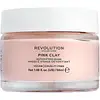What's inside
What's inside
 Key Ingredients
Key Ingredients

 Benefits
Benefits

 Concerns
Concerns

 Ingredients Side-by-side
Ingredients Side-by-side

Water
Skin ConditioningKaolin
AbrasiveAloe Barbadensis Leaf Juice
Skin ConditioningGlycerin
HumectantGlyceryl Stearate
EmollientCarthamus Tinctorius Seed Oil
MaskingStearic Acid
CleansingHelianthus Annuus Seed Oil
EmollientCetearyl Alcohol
EmollientMagnesium Aluminum Silicate
AbsorbentSodium Stearate
CleansingSodium Magnesium Silicate
Phenoxyethanol
PreservativeDimethyl Sulfone
SolventCentella Asiatica Extract
CleansingGlyceryl Caprylate
EmollientDecyl Glucoside
CleansingCellulose Gum
Emulsion StabilisingCocos Nucifera Oil
MaskingCetyl Alcohol
EmollientEthylhexylglycerin
Skin ConditioningSodium Carbomer
Emulsion StabilisingTocopherol
AntioxidantMacrocystis Pyrifera Extract
Skin ConditioningSea Water Extract
Skin ConditioningChondrus Crispus Extract
Skin ConditioningVitis Vinifera Seed Oil
EmollientLonicera Caprifolium Flower Extract
PerfumingSodium Hydroxide
BufferingLonicera Japonica Leaf Extract
Skin ConditioningTocopheryl Acetate
AntioxidantPanthenol
Skin ConditioningOryza Sativa Bran Oil
EmollientGeranium Maculatum Extract
TonicTaraxacum Officinale Extract
Skin ConditioningEquisetum Arvense Extract
AstringentSpirulina Maxima Extract
SmoothingPrunus Armeniaca Kernel Oil
MaskingWater, Kaolin, Aloe Barbadensis Leaf Juice, Glycerin, Glyceryl Stearate, Carthamus Tinctorius Seed Oil, Stearic Acid, Helianthus Annuus Seed Oil, Cetearyl Alcohol, Magnesium Aluminum Silicate, Sodium Stearate, Sodium Magnesium Silicate, Phenoxyethanol, Dimethyl Sulfone, Centella Asiatica Extract, Glyceryl Caprylate, Decyl Glucoside, Cellulose Gum, Cocos Nucifera Oil, Cetyl Alcohol, Ethylhexylglycerin, Sodium Carbomer, Tocopherol, Macrocystis Pyrifera Extract, Sea Water Extract, Chondrus Crispus Extract, Vitis Vinifera Seed Oil, Lonicera Caprifolium Flower Extract, Sodium Hydroxide, Lonicera Japonica Leaf Extract, Tocopheryl Acetate, Panthenol, Oryza Sativa Bran Oil, Geranium Maculatum Extract, Taraxacum Officinale Extract, Equisetum Arvense Extract, Spirulina Maxima Extract, Prunus Armeniaca Kernel Oil
Water
Skin ConditioningKaolin
AbrasiveMagnesium Aluminum Silicate
AbsorbentBentonite
AbsorbentGlycerin
HumectantXanthan Gum
EmulsifyingHamamelis Virginiana Water
AstringentPhenoxyethanol
PreservativeParfum
MaskingCitric Acid
Buffering1-Methylhydantoin-2-Imide
Skin ConditioningEthylhexylglycerin
Skin ConditioningMontmorillonite
AbsorbentIllite
Abrasive2-Bromo-2-Nitropropane-1,3-Diol
PreservativeFucus Vesiculosus Extract
EmollientAloe Barbadensis Leaf Juice Powder
Skin ConditioningPotassium Sorbate
PreservativeSodium Benzoate
MaskingCI 77491
Cosmetic ColorantWater, Kaolin, Magnesium Aluminum Silicate, Bentonite, Glycerin, Xanthan Gum, Hamamelis Virginiana Water, Phenoxyethanol, Parfum, Citric Acid, 1-Methylhydantoin-2-Imide, Ethylhexylglycerin, Montmorillonite, Illite, 2-Bromo-2-Nitropropane-1,3-Diol, Fucus Vesiculosus Extract, Aloe Barbadensis Leaf Juice Powder, Potassium Sorbate, Sodium Benzoate, CI 77491
 Reviews
Reviews

Ingredients Explained
These ingredients are found in both products.
Ingredients higher up in an ingredient list are typically present in a larger amount.
Ethylhexylglycerin (we can't pronounce this either) is commonly used as a preservative and skin softener. It is derived from glyceryl.
You might see Ethylhexylglycerin often paired with other preservatives such as phenoxyethanol. Ethylhexylglycerin has been found to increase the effectiveness of these other preservatives.
Glycerin is already naturally found in your skin. It helps moisturize and protect your skin.
A study from 2016 found glycerin to be more effective as a humectant than AHAs and hyaluronic acid.
As a humectant, it helps the skin stay hydrated by pulling moisture to your skin. The low molecular weight of glycerin allows it to pull moisture into the deeper layers of your skin.
Hydrated skin improves your skin barrier; Your skin barrier helps protect against irritants and bacteria.
Glycerin has also been found to have antimicrobial and antiviral properties. Due to these properties, glycerin is often used in wound and burn treatments.
In cosmetics, glycerin is usually derived from plants such as soybean or palm. However, it can also be sourced from animals, such as tallow or animal fat.
This ingredient is organic, colorless, odorless, and non-toxic.
Glycerin is the name for this ingredient in American English. British English uses Glycerol/Glycerine.
Learn more about GlycerinKaolin is a clay. It is used for oil control and to help minimize pores. Like other clays, kaolin has the ability to absorb excess sebum or oil. This can help clean out pores and mattify the skin.
Some types of kaolin may have exfoliating properties. When water is added to kaolin, it becomes a paste with small abrasive particles.
Most kaolin is a white color, but may be pink/orange/red depending on where it comes from.
The name 'kaolin' comes from a Chinese village named 'Gaoling'. Kaolin clay comes from rocks rich in kaolinite. Kaolinite, the mineral, has a silicate layered structure. Kaolinite is formed from chemical weathering of aluminum siilicate minerals.
Besides skincare, kaolin is commonly used to make glossy paper, in ceramics, toothpaste, and as medicine to soothe stomach issues.
Learn more about KaolinMagnesium Aluminum Silicate is a type of silica. It comes from naturally occuring minerals such as silicate ores and clay.
Magnesium aluminum silicate is used for enhancing texture and as an absorbent. Due to its large molecular size, it is unable to be absorbed into the skin.
Like other types of silica, this ingredient can be used to thicken a product. As an absorbent, it may be used to absorb extra water or help prevent clumping.
Although “aluminum” in an ingredient name can raise red flags for some consumers, the form and usage context matter significantly. For typical topical applications, there is no substantial evidence of health risks - such as cancer, neurotoxicity, or systemic “aluminum overload.”
Learn more about Magnesium Aluminum SilicatePhenoxyethanol is a preservative that has germicide, antimicrobial, and aromatic properties. Studies show that phenoxyethanol can prevent microbial growth. By itself, it has a scent that is similar to that of a rose.
It's often used in formulations along with Caprylyl Glycol to preserve the shelf life of products.
Water. It's the most common cosmetic ingredient of all. You'll usually see it at the top of ingredient lists, meaning that it makes up the largest part of the product.
So why is it so popular? Water most often acts as a solvent - this means that it helps dissolve other ingredients into the formulation.
You'll also recognize water as that liquid we all need to stay alive. If you see this, drink a glass of water. Stay hydrated!
Learn more about Water